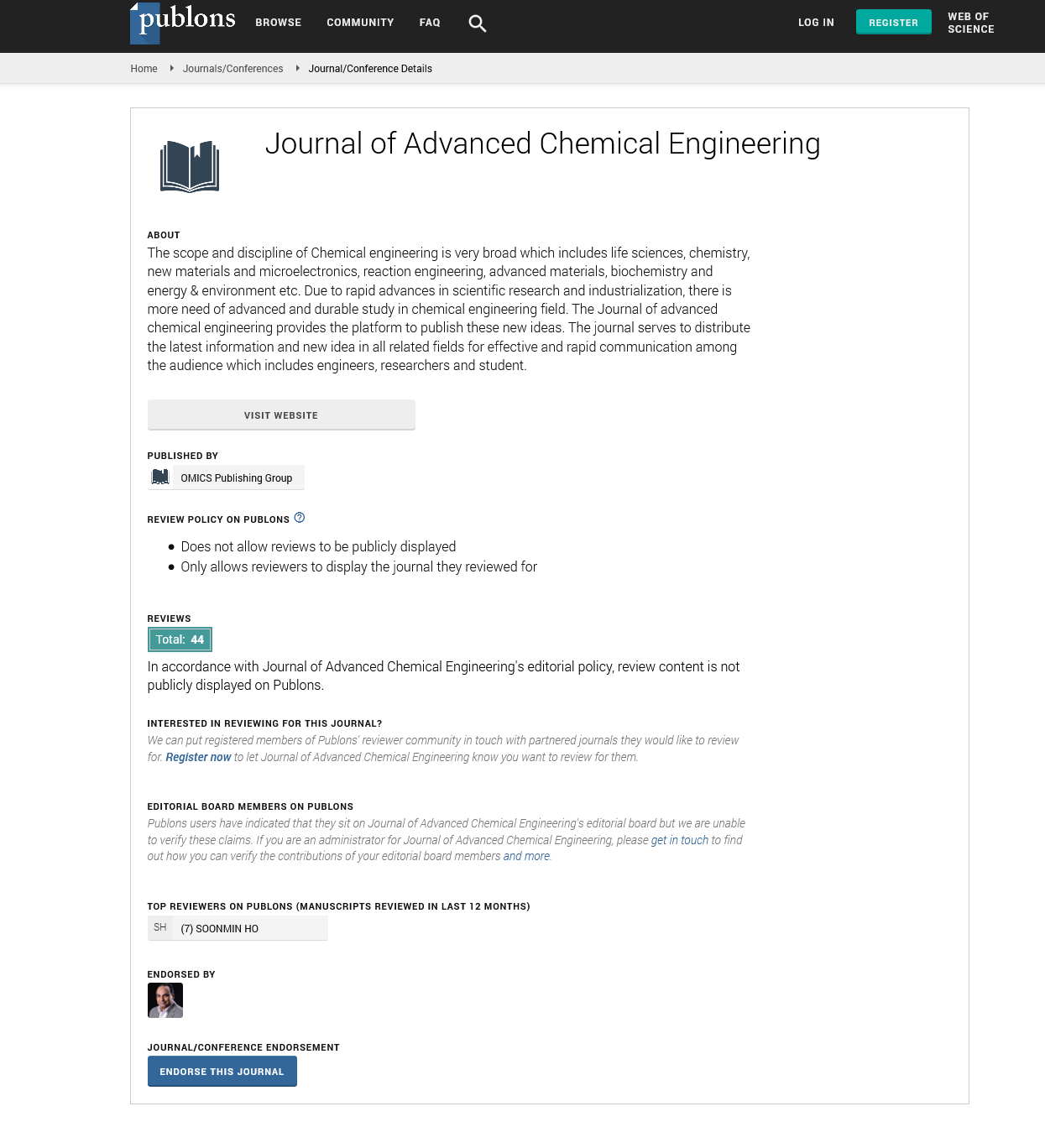Indexed In
- Open J Gate
- Genamics JournalSeek
- Smithers Rapra
- RefSeek
- Directory of Research Journal Indexing (DRJI)
- Hamdard University
- EBSCO A-Z
- OCLC- WorldCat
- Scholarsteer
- Publons
- Geneva Foundation for Medical Education and Research
- Google Scholar
Useful Links
Share This Page
Journal Flyer

Open Access Journals
- Agri and Aquaculture
- Biochemistry
- Bioinformatics & Systems Biology
- Business & Management
- Chemistry
- Clinical Sciences
- Engineering
- Food & Nutrition
- General Science
- Genetics & Molecular Biology
- Immunology & Microbiology
- Medical Sciences
- Neuroscience & Psychology
- Nursing & Health Care
- Pharmaceutical Sciences
Perspective - (2025) Volume 15, Issue 2
Biorefineries: The Future of Sustainable Chemical Production
Laura Stein*Received: 30-May-2025, Manuscript No. ACE-25-29806; Editor assigned: 02-Jun-2025, Pre QC No. ACE-25-29806 (PQ); Reviewed: 16-Jun-2025, QC No. ACE-25-29806; Revised: 23-Jun-2025, Manuscript No. ACE-25-29806 (R); Published: 30-Jun-2025, DOI: 10.35248/2090-4568.25.15.367
Description
The increasing demand for sustainable resources and the urgent need to reduce dependence on fossil fuels have given rise to the concept of biorefineries, which promise to transform biomass into a wide range of valuable products. A biorefinery can be seen as the biological equivalent of a petroleum refinery, where renewable feedstocks such as agricultural residues, forestry byproducts, or dedicated energy crops are converted into fuels, chemicals, materials, and energy. Chemical engineering plays a vital role in designing and operating these facilities, integrating biological and chemical processes into efficient, cost-effective, and environmentally friendly systems. The evolution of biorefineries is not only a technological innovation but also a societal necessity, as it represents a pathway toward a circular economy and a more sustainable industrial future.
Biomass is unique among renewable resources because it contains carbon, which makes it particularly suitable as a feedstock for fuels and chemicals. Unlike solar or wind energy, which produce electricity, biomass can be processed into liquid fuels, polymers, and specialty chemicals that are essential for modern life. The challenge, however, lies in unlocking this potential in ways that are both economically viable and environmentally sound. Chemical engineers are tasked with overcoming technical hurdles such as biomass heterogeneity, low energy density, and complex chemical composition. By applying principles of reaction engineering, catalysis, separation processes, and process intensification, they are gradually transforming the concept of biorefineries into a commercial reality.
One of the primary products of biorefineries is biofuel, which comes in various forms such as ethanol, biodiesel, and advanced biofuels like cellulosic ethanol or synthetic hydrocarbons. Ethanol production from corn or sugarcane is already well established, particularly in countries like Brazil and the United States. However, the focus is now shifting toward second-generation biofuels derived from lignocellulosic biomass, which includes agricultural residues like corn stover, wheat straw, or forestry waste. These feedstocks are abundant and do not compete directly with food supplies, making them more sustainable. The conversion of lignocellulosic material into fermentable sugars is technically challenging due to the recalcitrant structure of cellulose, hemicellulose, and lignin. Chemical engineers are developing pretreatment methods—such as steam explosion, acid hydrolysis, or enzymatic digestion—to break down these structures and improve yields.
Beyond fuels, biorefineries can produce a wide range of chemicals that traditionally come from petroleum. For example, platform chemicals such as succinic acid, lactic acid, and furfural can be derived from biomass and serve as building blocks for polymers, solvents, and specialty products. Lactic acid, for instance, is used to make Polylactic Acid (PLA), a biodegradable plastic that offers a sustainable alternative to conventional plastics. Similarly, succinic acid can be converted into biodegradable polyesters. These developments highlight the potential for biorefineries to not only reduce reliance on fossil resources but also tackle the global plastic waste crisis by promoting biodegradable alternatives.
The integration of multiple product streams is what distinguishes biorefineries from simple biofuel plants. By producing a spectrum of fuels, chemicals, and materials, biorefineries can achieve higher economic viability and resource efficiency. This concept mirrors the petroleum refinery model, where crude oil is fractionated into gasoline, diesel, jet fuel, lubricants, and petrochemicals. In a biorefinery, lignin, which is often treated as waste, can be used to produce energy, resins, or carbon fibers. Hemicellulose-derived sugars can be converted into specialty chemicals, while cellulose is used for ethanol production. Such integrated approaches maximize value creation and minimize waste, embodying the principles of a circular economy.
The environmental benefits of biorefineries are significant. By substituting fossil feedstocks with renewable biomass, greenhouse gas emissions can be reduced substantially. Moreover, many biomass feedstocks can be sourced locally, reducing dependence on imported fossil fuels and enhancing energy security. Biorefineries can also promote rural development by creating new markets for agricultural residues and energy crops. However, the environmental sustainability of biorefineries depends on careful management of land use, water resources, and biodiversity. Large-scale biomass cultivation must avoid deforestation, soil degradation, and competition with food production. Life Cycle Assessment (LCA) is an essential tool used by chemical engineers to evaluate the true environmental impact of biorefinery processes and guide improvements.
Citation: Stein L (2025). Biorefineries: The Future of Sustainable Chemical Production. Adv Chem Eng. 15:367.
Copyright: © 2025 Stein L. This is an open-access article distributed under the terms of the Creative Commons Attribution License, which permits unrestricted use, distribution, and reproduction in any medium, provided the original author and source are credited.

